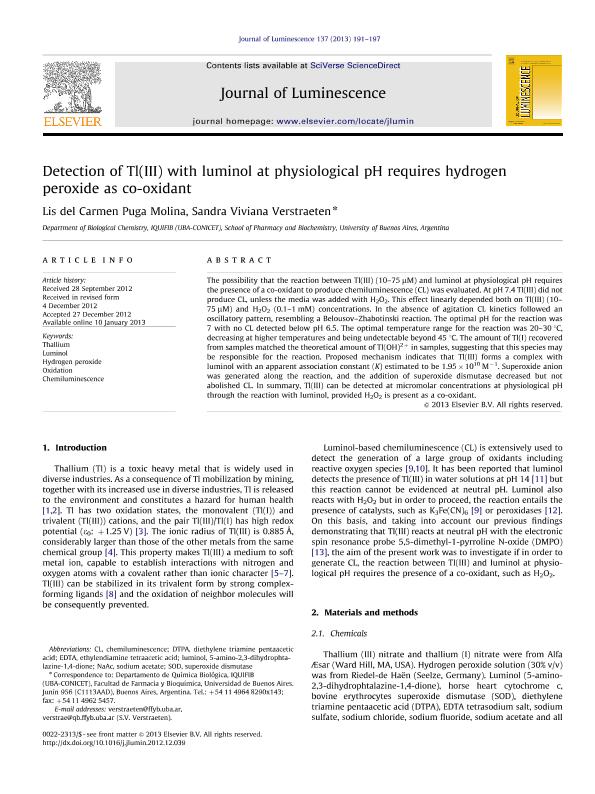Artículo
Detection of Tl(III) with luminol at physiological pH requires hydrogen peroxide as co-oxidant
Fecha de publicación:
05/2013
Editorial:
Elsevier Science
Revista:
Journal Of Luminescence
ISSN:
0022-2313
Idioma:
Inglés
Tipo de recurso:
Artículo publicado
Clasificación temática:
Resumen
The possibility that the reaction between Tl(III) (10–75 μM) and luminol at physiological pH requires the presence of a co-oxidant to produce chemiluminescence (CL) was evaluated. At pH 7.4 Tl(III) did not produce CL, unless the media was added with H2O2. This effect linearly depended both on Tl(III) (10–75 μM) and H2O2 (0.1–1 mM) concentrations. In the absence of agitation CL kinetics followed an oscillatory pattern, resembling a Belousov–Zhabotinski reaction. The optimal pH for the reaction was 7 with no CL detected below pH 6.5. The optimal temperature range for the reaction was 20–30 °C, decreasing at higher temperatures and being undetectable beyond 45 °C. The amount of Tl(I) recovered from samples matched the theoretical amount of Tl(OH)2+ in samples, suggesting that this species may be responsible for the reaction. Proposed mechanism indicates that Tl(III) forms a complex with luminol with an apparent association constant (K) estimated to be 1.95×1010 M−1. Superoxide anion was generated along the reaction, and the addition of superoxide dismutase decreased but not abolished CL. In summary, Tl(III) can be detected at micromolar concentrations at physiological pH through the reaction with luminol, provided H2O2 is present as a co-oxidant.
Palabras clave:
Thallium
,
Luminol
,
Hydrogen Peroxide
,
Chemiluminescence
Archivos asociados
Licencia
Identificadores
Colecciones
Articulos(IQUIFIB)
Articulos de INST.DE QUIMICA Y FISICO-QUIMICA BIOLOGICAS "PROF. ALEJANDRO C. PALADINI"
Articulos de INST.DE QUIMICA Y FISICO-QUIMICA BIOLOGICAS "PROF. ALEJANDRO C. PALADINI"
Articulos(OCA HOUSSAY)
Articulos de OFICINA DE COORDINACION ADMINISTRATIVA HOUSSAY
Articulos de OFICINA DE COORDINACION ADMINISTRATIVA HOUSSAY
Citación
Puga Molina, Lis del Carmen; Verstraeten, Sandra Viviana; Detection of Tl(III) with luminol at physiological pH requires hydrogen peroxide as co-oxidant; Elsevier Science; Journal Of Luminescence; 137; 5-2013; 191-197
Compartir
Altmétricas




